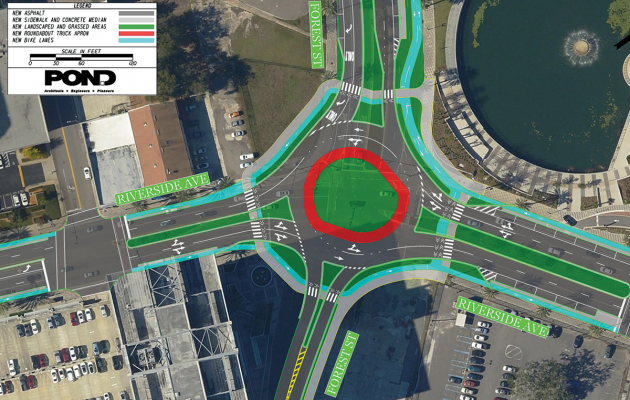Brooklyn Road Diet recommendations include roundabout
Posted on November 9, 2017 By Editor Articles, Neighborhood News, Top Stories

Consultants working on a plan to make Riverside Avenue through the Brooklyn area more pedestrian- and bicycle-friendly gave their final recommendations to the Downtown Investment Authority Board of Directors Sept. 21.
With the goal of reducing accidents, increasing walking and bicycling, and enhancing economic development in that neighborhood, the consultants tweaked their initial recommendations after getting feedback July 27 at a second public workshop.
The recommendations include adding a buffered bike lane with sidewalk along Riverside Avenue, a bike lane with sidewalk along Park and Forest Streets, and multi-use trails with one leading from Riverside Avenue to the Northbank Riverwalk and another traversing the Acosta Bridge and Riverside Avenue interchange.
The protected two-way bicycle lane on Park Street would include on-street parallel parking, improved pedestrian facilities, such as a bus rapid transit (BRT) stop, and wayfinding signs. Park Street would change from a four-lane to a two-lane road.
The consultants – POND & Company, and Dover, Kohl & Partners – also suggested adding a roundabout where Forest Street joins Riverside Avenue, a mid-block pedestrian crossing on Forest Street near Unity Plaza, and additional signals on Riverside Avenue and Park Street.
The Riverside Avenue concept also includes a buffered bike lane, on-street parking and protected pedestrian crossings. Riverside Avenue is currently a six-lane roadway with unprotected bike lanes in both directions. The recommendation would change it to four lanes with two protected bike lanes and parallel parking in both directions.
The consultants deemed the intersection of Riverside Avenue and Forest Street to have an “awkward alignment within the intersection, which causes confusion for pedestrians and drivers.” To rectify the situation, they proposed a roundabout to provide slower speeds, a distinctive gateway to the river, and clear travel lanes.
One of the most challenging sites for overhaul is the Acosta Bridge and Riverside Avenue interchange, which has a narrow walkway, high-speed crosswalk and discontinuous bike lanes. Possible improvements include narrowing travel lanes to create a protected two-way multi-use path for pedestrians and cyclists.
In the consultants’ opinions, make these changes will help enhance economic development in the Brooklyn-Riverside area by attracting more pedestrians and bicyclists, which may spur new development opportunities and, in turn, “increase the ‘hip destination’ identity of the area.”
In the short term
All those recommendations will require major funding, so in the short-term, POND & Company recommended enhanced lighting, pedestrian signals with countdown timers and wayfinding signage through the study area.
On Forest Street, they recommended restriping to add a buffered bike lane and parking, a new sidewalk on the west side of Magnolia Street and a midblock crossing at Magnolia Street. Additionally, a bike box was suggested to offer cyclists a safe way to make a left turn from Forest Street northbound onto Riverside Avenue from a right side bike lane.
Park Street short-term changes would include providing pedestrian access around the pond at Unity Plaza, a sidewalk on the west side of Jackson Street, and tactics to introduce a trial road diet to the community.
Short-term recommendations for River-side Avenue include conversion of the outermost northbound lane to a parking lane with a bicycle lane against the existing curb and conversion of the outermost southbound lane to greenspace and sidewalk with a bicycle lane adjacent to a new curb.
Additional short-term enhancements on Riverside include replacing palm trees with shade trees, installing “bulb outs” to reduce crossing distances, installing pedestrian countdown timers, and restriping for the buffered bike lanes.
Next steps include presentation of cost estimates, both short- and long-term, to the DIA, which anticipates receiving the information in November, according to Guy Parola, DIA operations manager.
By Kate A. Hallock
Resident Community News




 (No Ratings Yet)
(No Ratings Yet)




